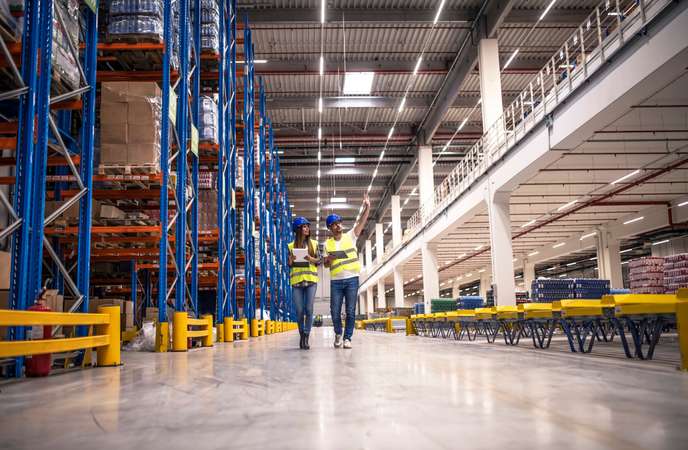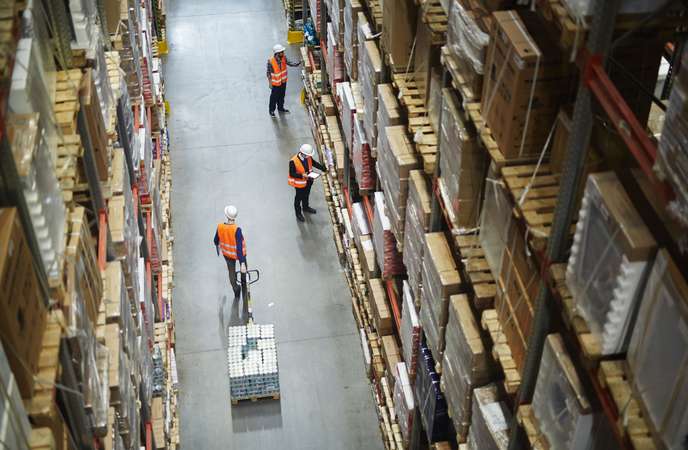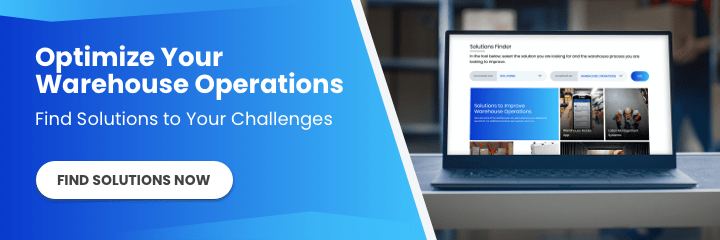Planning a warehouse layout design can be a complex process due to the various factors involved. This process includes strategically planning a facility layout that can properly utilize the space available, facilitate the smooth functioning of warehouse operations, and increase efficiency.
This article will help you understand the importance of a practical warehouse layout design and discuss some of the most crucial principles that you should consider while designing the layout for your warehouse.
Importance of a Practical Warehouse Layout Design
Designing a practical warehouse layout is a crucial process as it has a direct impact on the efficiency and productivity of your warehouse. The planned layout should arrange the processes in a logical sequence that can help streamline operations, boost productivity, and reduce expenses. A well-executed and optimized warehouse layout design can provide easy access to stored goods, minimize travel time, and improve order fulfillment rates.
Additionally, it is vital to consider all the requirements according to your business needs during the planning phase itself. This is because altering the planned layout once the construction of your facility starts is costly due to the additional material and labor costs involved.

Principles to Consider While Designing Your Warehouse Layout
Considering the principles below can help you design an efficient layout and streamline warehouse operations. Here are some of the most crucial factors to consider:
Budget Considerations
Before starting with the design of your warehouse layout, it is essential to assess all your business requirements, review associated budgets, and then plan the layout accordingly. During this process, you might come across some layout designs that are more comprehensive and expensive than others, but it is recommended that you consider the most suitable and cost-efficient solution for your warehouse.
Space Available
Effectively utilizing the warehouse space available can help improve inventory visibility, reduce travel time, and increase overall operational efficiency. When designing your warehouse layout, it is crucial to allocate maximum space to storage and inventory processing purposes while minimizing space for office areas, empty pallets, charging stations, etc. Additionally, how you decide to allocate space will impact shelving designs, installation capacity, and placement of goods inside your facility.
Flow
Ensuring the uninterrupted flow of goods, personnel, and equipment is vital to consider in the design layout for the smooth functioning of your warehouse. You can avoid inefficient routes and disruptions by strategically planning your warehouse layout design so as to facilitate each operation in a sequential manner.
Accessibility
While planning your warehouse layout, it is crucial to ensure easy accessibility to all the areas and products in your facility. The layout should be designed in a way that makes it easy for personnel to navigate throughout the facility while conveniently locating and picking items without having to move other products. As a result, your productivity can be enhanced and orders can be fulfilled at a faster rate.
Equipment
The use of different types of equipment in your warehouse, such as lifting & packing tools, pallet racks, or conveyors, can influence the layout design. By identifying the equipment needed, you can evaluate and design the most suitable layout according to your requirements and boost the productivity of your facility.
Throughput
Throughput in a warehouse refers to the number of products that are processed and moved through various warehouse processes such as receiving, putaway, storage, picking, packing, and shipping. By collecting and analyzing this data, you can design a layout to ensure an efficient flow of goods and accommodate the necessary equipment for your warehouse.
Personnel
Knowing the number of people required, their current levels of training and shift timings, and other related factors can help you design your warehouse layout in a way that doesn’t limit your workforce’s productivity. Also, the layout must be planned in a manner that can safely accommodate new employees and their needs in the future.

Authority Guidelines
While designing your warehouse layout, it is critical to comply with the guidelines provided by the local authorities. Abiding by these guidelines not only ensures the safety of your workers, equipment, or other valuable assets but also helps you avoid fines and legal problems for your business.
Summary
Selecting the most suitable warehouse layout design for your facility is crucial to ensure the optimal utilization of resources. The best way to make sure that this task does not get overwhelming for you is to consider the factors mentioned in this article. This can help you design your layout in an efficient manner, which in turn lets you utilize your warehouse space better, boost productivity, and improve order fulfillment rates.
Besides layout design, choosing the right warehouse location can also significantly enhance your ability to compete and effectively serve customers. Check out the 7 critical criteria you must consider while choosing a warehouse to properly plan and understand the most strategic location for your warehouse.
If you’re looking for the right solutions to optimize your warehouse, go to our Solutions Finder tool.
If you want to learn more about warehouse digitalization and optimizing warehouse processes, you can follow us on LinkedIn, YouTube, Twitter, or Facebook. If you have other inquiries or suggestions, don’t hesitate to contact us here. We’ll be happy to hear from you.
- SEO Powered Content & PR Distribution. Get Amplified Today.
- PlatoData.Network Vertical Generative Ai. Empower Yourself. Access Here.
- PlatoAiStream. Web3 Intelligence. Knowledge Amplified. Access Here.
- PlatoESG. Carbon, CleanTech, Energy, Environment, Solar, Waste Management. Access Here.
- PlatoHealth. Biotech and Clinical Trials Intelligence. Access Here.
- Source: https://articles.cyzerg.com/warehouse-layout-design-principles
- :has
- :is
- :not
- 8
- a
- ability
- About
- access
- accessibility
- accommodate
- According
- accordingly
- across
- Additional
- Additionally
- advanced
- affordable
- All
- allocate
- also
- an
- analyzing
- and
- ARE
- areas
- article
- AS
- assess
- Assets
- associated
- At
- Authorities
- available
- avoid
- banner
- BE
- because
- below
- BEST
- Better
- Blog
- boost
- Budgets
- business
- but
- by
- CAN
- Capacity
- charging
- charging stations
- choosing
- click
- code
- Collecting
- come
- compete
- complex
- comply
- comprehensive
- Consider
- construction
- conveniently
- costly
- Costs
- criteria
- critical
- crucial
- CTA
- Current
- Customers
- data
- decide
- Design
- designed
- designing
- designs
- different
- digitalization
- direct
- discuss
- disruptions
- does
- Doesn’t
- Dont
- due
- during
- each
- easy
- effectively
- efficiency
- efficient
- employees
- empty
- end
- enhance
- enhanced
- ensure
- ensures
- equipment
- essential
- etc
- Ether (ETH)
- evaluate
- expenses
- expensive
- facilitate
- Facility
- factors
- faster
- Finder
- fines
- flow
- follow
- For
- from
- fulfillment
- functioning
- future
- get
- goods
- guidelines
- happy
- Have
- having
- hear
- help
- helps
- here
- How
- HTTPS
- HubSpot
- identifying
- ie
- if
- Impact
- importance
- improve
- in
- includes
- Increase
- inefficient
- influence
- Inquiries
- inside
- installation
- inventory
- involved
- IT
- items
- itself
- jpg
- labor
- Layout
- LEARN
- Legal
- Lets
- levels
- lifting
- LIMIT
- local
- location
- logical
- looking
- make
- MAKES
- manner
- material
- max-width
- maximum
- mentioned
- Middle
- might
- minimize
- minimizing
- more
- most
- move
- moved
- must
- Navigate
- necessary
- needs
- New
- number
- of
- Office
- on
- once
- only
- operation
- operational
- Operations
- optimal
- Optimize
- optimizing
- or
- order
- orders
- Other
- Others
- out
- overall
- overwhelming
- People
- Personnel
- phase
- placement
- plan
- planned
- planning
- plato
- Plato Data Intelligence
- PlatoData
- Practical
- principles
- problems
- process
- processed
- processes
- processing
- productivity
- Products
- properly
- provide
- provided
- purposes
- Rate
- Rates
- RE
- receiving
- recommended
- reduce
- refers
- related
- required
- Requirements
- Resources
- result
- review
- right
- routes
- safely
- Sequence
- serve
- shift
- Shipping
- should
- significantly
- smooth
- So
- solution
- Solutions
- some
- Space
- Starting
- starts
- Stations
- storage
- stored
- Strategic
- Strategically
- streamline
- such
- suitable
- sure
- Task
- than
- that
- The
- The Future
- their
- then
- These
- this
- Through
- throughout
- time
- timings
- to
- tool
- tools
- Training
- travel
- TURN
- types
- understand
- us
- use
- utilize
- Utilizing
- Valuable
- various
- visibility
- vital
- want
- Warehouse
- Warehouse Operations
- Way..
- when
- which
- while
- will
- with
- without
- WMS
- you
- Your
- youtube
- zephyrnet















